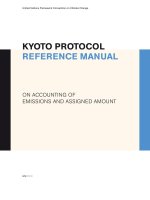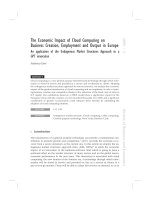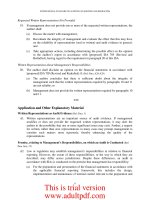CH14 options on stock indices, currencies, and futures
Bạn đang xem bản rút gọn của tài liệu. Xem và tải ngay bản đầy đủ của tài liệu tại đây (673.29 KB, 38 trang )
14.1
Options on Stock Indices, Currencies, and
Futures
Chapter 14
14.2
European Options on Stocks
Providing a Dividend Yield
We get the same probability distribution for the stock price at
time T in each of the following cases:
1. The stock starts at price S
0
and provides a dividend yield =
q
2. The stock starts at price S
0
e
–q T
and provides no income
14.3
European Options on Stocks
Providing Dividend Yield
continued
We can value European options by reducing the stock price to S
0
e
–q T
and then behaving as though there is no dividend
14.4
Extension of Chapter 9 Results
(Equations 14.1 to 14.3)
Lower Bound for calls:
Lower Bound for puts
Put Call Parity
rTqT
KeeSc
−−
−≥
0
qTrT
eSKep
−−
−≥
0
qTrT
eSpKec
−−
+=+
0
14.5
Extension of Chapter 13 Results (Equations 14.4 and 14.5)
T
TqrKS
d
T
TqrKS
d
dNeSdNKep
dNKedNeSc
qTrT
rTqT
σ
σ−−+
=
σ
σ+−+
=
−−−=
−=
−−
−−
)2/
2
()/ln(
)2/
2
()/ln(
)()(
)()(
0
2
0
1
102
210
where
14.6
The Binomial Model
S
0
u
ƒ
u
S
0
d
ƒ
d
S
0
ƒ
p
(
1
–
p
)
f=e
-rT
[pf
u
+(1-p)f
d
]
14.7
The Binomial Model
continued
In a risk-neutral world the stock price grows at r-q rather than at r
when there is a dividend yield at rate q
The probability, p, of an up movement must therefore satisfy
pS
0
u+(1-p)S
0
d=S
0
e
(r-q)T
so that
p
e d
u d
r q T
=
−
−
−( )
14.8
Index Options (page 316-321)
The most popular underlying indices in the U.S. are
The Dow Jones Index times 0.01 (DJX)
The Nasdaq 100 Index (NDX)
The Russell 2000 Index (RUT)
The S&P 100 Index (OEX)
The S&P 500 Index (SPX)
Contracts are on 100 times index; they are settled in cash; OEX is American
and the rest are European.
14.9
LEAPS
Leaps are options on stock indices that last up to 3 years
They have December expiration dates
They are on 10 times the index
Leaps also trade on some individual stocks
14.10
Index Option Example
Consider a call option on an index with a strike price of 560
Suppose 1 contract is exercised when the index level is 580
What is the payoff?
14.11
Using Index Options for Portfolio Insurance
Suppose the value of the index is S
0
and the strike price is K
If a portfolio has a β of 1.0, the portfolio insurance is obtained by buying 1 put option
contract on the index for each 100S
0
dollars held
If the β is not 1.0, the portfolio manager buys β put options for each 100S
0
dollars held
In both cases, K is chosen to give the appropriate insurance level
14.12
Example 1
Portfolio has a beta of 1.0
It is currently worth $500,000
The index currently stands at 1000
What trade is necessary to provide insurance against the portfolio value
falling below $450,000?
14.13
Example 2
Portfolio has a beta of 2.0
It is currently worth $500,000 and index stands at 1000
The risk-free rate is 12% per annum
The dividend yield on both the portfolio and the index is 4%
How many put option contracts should be purchased for portfolio
insurance?
14.14
If index rises to 1040, it provides a 40/1000 or 4% return in 3 months
Total return (incl dividends)=5%
Excess return over risk-free rate=2%
Excess return for portfolio=4%
Increase in Portfolio Value=4+3-1=6%
Portfolio value=$530,000
Calculating Relation Between Index Level and Portfolio Value in 3 months
14.15
Determining the Strike Price (Table 14.2, page 320)
An option with a strike price of 960 will provide protection against a 10% decline in the portfolio value
Value of Index in 3
months
Expected Portfolio Value
in 3 months ($)
1,080 570,000
1,040 530,000
1,000 490,000
960 450,000
920 410,000
14.16
Valuing European Index Options
We can use the formula for an option on a stock paying a dividend
yield
Set S
0
= current index level
Set q = average dividend yield expected during the life of the option
14.17
Currency Options
Currency options trade on the Philadelphia Exchange (PHLX)
There also exists an active over-the-counter (OTC) market
Currency options are used by corporations to buy insurance when they
have an FX exposure
14.18
The Foreign Interest Rate
We denote the foreign interest rate by r
f
When a U.S. company buys one unit of the foreign currency it has an
investment of S
0
dollars
The return from investing at the foreign rate is r
f
S
0
dollars
This shows that the foreign currency provides a “dividend yield” at
rate r
f
14.19
Valuing European Currency Options
A foreign currency is an asset that provides a “dividend yield”
equal to r
f
We can use the formula for an option on a stock paying a
dividend yield :
Set S
0
= current exchange rate
Set q = r
ƒ
14.20
Formulas for European Currency Options
(Equations 14.7 and 14.8, page 322)
T
T
f
rrKS
d
T
T
f
rrKS
d
dNeSdNKep
dNKedNeSc
Tr
rT
rT
Tr
f
f
σ
σ−−+
=
σ
σ+−+
=
−−−=
−=
−
−
−
−
)2/
2
()/ln(
)2/
2
()/ln(
)()(
)()(
0
2
0
1
102
210
where
14.21
Alternative Formulas
(Equations 14.9 and 14.10, page 322)
Using
F S e
r r T
f
0 0
=
−( )
Tdd
T
TKF
d
dNFdKNep
dKNdNFec
rT
rT
σ−=
σ
σ+
=
−−−=
−=
−
−
12
2
0
1
102
210
2/)/ln(
)]()([
)]()([
14.22
Mechanics of Call Futures Options
When a call futures option is exercised the holder acquires
1. A long position in the futures
2. A cash amount equal to the excess of
the futures price over the strike price
14.23
Mechanics of Put Futures Option
When a put futures option is exercised the holder acquires
1. A short position in the futures
2. A cash amount equal to the excess of
the strike price over the futures price
14.24
The Payoffs
If the futures position is closed out immediately:
Payoff from call = F
0
– K
Payoff from put = K – F
0
where F
0
is futures price at time of exercise
14.25
Put-Call Parity for Futures Options (Equation 14.11, page 329)
Consider the following two portfolios:
1. European call plus Ke
-rT
of cash
2. European put plus long futures plus cash equal to F
0
e
-rT
They must be worth the same at time T so that
c+Ke
-rT
=p+F
0
e
-rT









